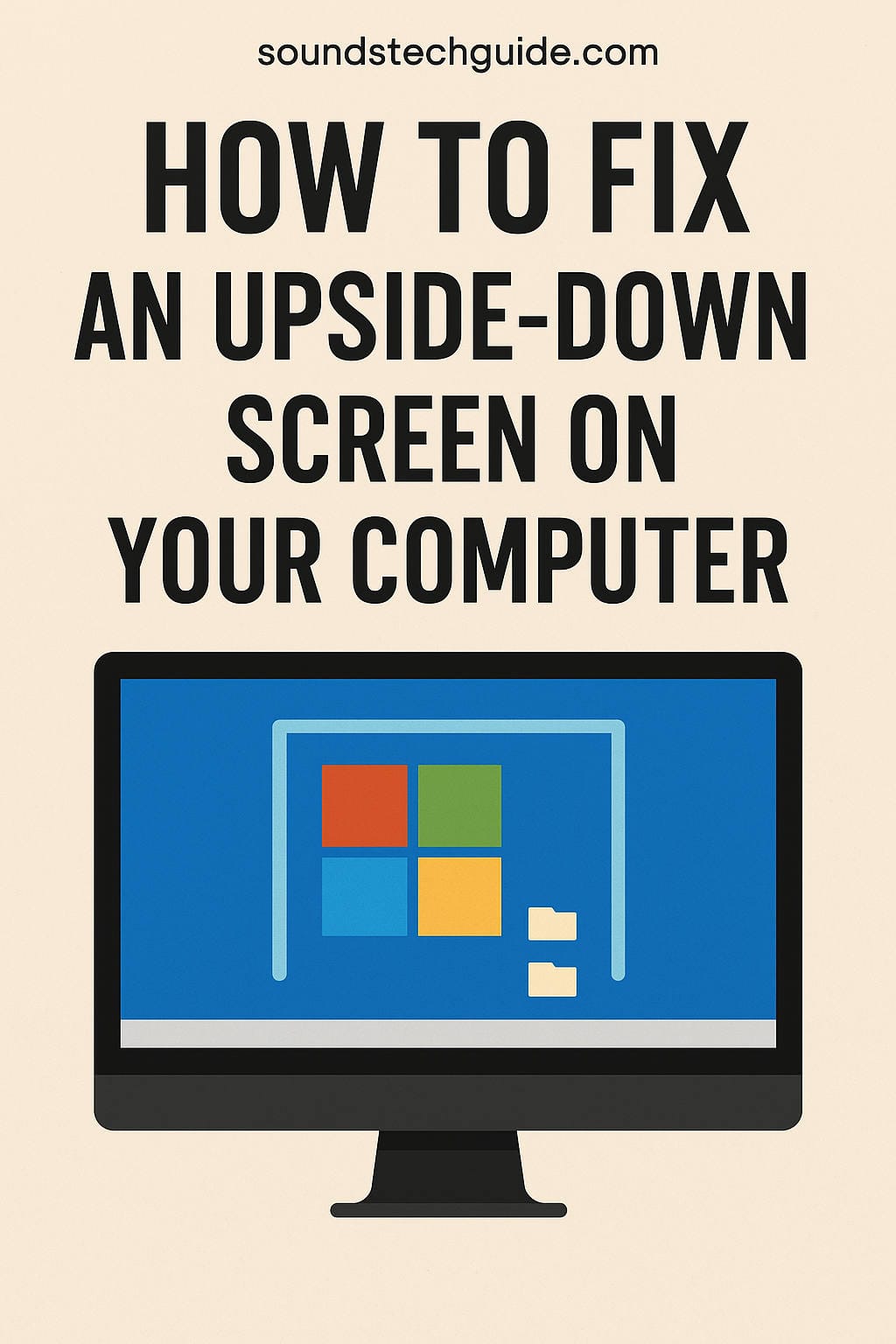There’s nothing quite as confusing as suddenly discovering your computer screen has flipped upside down. Whether it’s a simple mistake—like hitting the wrong keyboard shortcut—or something more technical, an inverted screen can be disorienting and frustrating. The good news? It’s usually a simple fix.
In this in-depth guide, we’ll cover multiple ways to fix an upside-down screen on both Windows and macOS systems. You’ll also learn how to prevent this issue from happening again and what to do if nothing seems to work. This guide is written with all users in mind, from tech-savvy individuals to beginners who’ve never dabbled in system settings before.
Let’s get your screen turned right side up again.
Common Reasons Why Your Screen Is Upside Down
Before diving into the fixes, it’s helpful to understand what might cause this issue in the first place:
- Keyboard Shortcut Activation: Accidentally pressing a key combination can trigger the screen rotation.
- Display Settings Misconfiguration: Sometimes, updates or driver changes can alter your display settings.
- Graphics Driver Glitches: Bugs or conflicts within your graphics card software can result in orientation problems.
- Multiple Monitor Confusion: If you’re using more than one monitor, settings for individual displays might get mixed up.
- Third-Party Software: Some software applications can interfere with system settings, including screen rotation.
Understanding the cause can help you better troubleshoot and even avoid the problem in the future.
Method 1: Use Keyboard Shortcuts on Windows
One of the fastest ways to fix an upside-down screen on a Windows computer is by using keyboard shortcuts. This trick works on most systems that support Intel integrated graphics.
Try These Key Combinations:
- Ctrl + Alt + Up Arrow: Sets screen to default orientation (right side up)
- Ctrl + Alt + Down Arrow: Flips screen upside down
- Ctrl + Alt + Left Arrow: Rotates screen 90 degrees to the left
- Ctrl + Alt + Right Arrow: Rotates screen 90 degrees to the right
What to Do:
- Hold down the Ctrl and Alt keys.
- While holding them, press the Up Arrow key.
- The screen should instantly revert to its normal orientation.
Note: These shortcuts may not work if your system’s graphics drivers don’t support them or if they’ve been disabled.
Method 2: Adjust Display Settings in Windows
If the shortcut keys don’t work or your display orientation doesn’t change, the next option is to manually adjust your screen settings.
Step-by-Step Instructions:
- Right-click anywhere on your desktop.
- Select Display settings from the context menu.
- Scroll down to the section labeled Display orientation.
- Click the drop-down menu and select Landscape.
- Click Apply.
- A confirmation message will appear. Choose Keep changes to lock in the orientation.
Bonus Tip for Multi-Monitor Users:
If you have more than one monitor connected:
- Make sure to select the correct screen at the top of the display settings window before adjusting the orientation.
This method is especially useful for users who prefer graphical interfaces over keyboard shortcuts.
Method 3: Use Graphics Card Control Panel
Modern computers often come equipped with dedicated graphics cards from manufacturers like Intel, NVIDIA, or AMD. Each of these comes with its own control panel for managing display settings.
For Intel Graphics:
- Right-click on the desktop and select Intel Graphics Settings or Graphics Properties.
- Navigate to Display.
- Find the Rotation setting and choose 0 degrees or Normal.
- Click Apply.
For NVIDIA Graphics:
- Right-click and choose NVIDIA Control Panel.
- Under the Display section, select Rotate display.
- Choose Landscape to reset to normal orientation.
- Apply the changes.
For AMD Radeon Graphics:
- Right-click and open AMD Radeon Settings.
- Go to the Display tab.
- Locate the Rotation option and set it to 0°.
- Apply the settings.
These software tools provide more granular control over your display, especially in multi-monitor or high-resolution setups.
Fixing an Upside-Down Screen on macOS
Although screen inversion is less common on macOS, it can still occur—especially with external monitors or after system updates.
Standard Fix Method:
- Click the Apple Menu and select System Settings or System Preferences.
- Choose Displays.
- If your Mac supports screen rotation, you’ll see a Rotation drop-down menu.
- Select Standard or 0°.
- Confirm the change if prompted.
Extra Tip:
If the Rotation option doesn’t appear:
- Hold down the Option key while clicking Displays. This reveals additional hidden options on some Mac models.
Note: Not all Macs support rotation, especially on the built-in Retina displays.
How to Prevent Future Screen Flips
Once you’ve fixed your screen, it’s wise to take a few steps to prevent it from flipping again.
Disable Screen Rotation Hotkeys (Windows with Intel Graphics)
- Open Intel Graphics Settings.
- Go to Options and Support.
- Select Hot Key Manager.
- Disable the hotkeys related to screen rotation.
Keep Drivers Updated
Outdated or corrupted drivers can cause display issues. Make sure to regularly update:
- Graphics drivers (Intel, NVIDIA, AMD)
- Operating system updates
- Monitor drivers, if applicable
Avoid Accidental Keystrokes
If you often hit keyboard shortcuts unintentionally, consider:
- Using a keyboard remapping tool
- Purchasing a keyboard with customizable keys
- Being cautious when using Ctrl + Alt combinations
If multiple users access your computer:
- Set up a Guest Account with limited permissions.
- Use Group Policy Editor (for Windows Pro) to lock down display settings.
Troubleshooting: What If None of These Fixes Work?
Sometimes, deeper system issues may prevent your screen from returning to normal. If all the above methods fail, here are some advanced steps to consider:
Perform a System Restore (Windows)
- Open the Start Menu and type System Restore.
- Follow the prompts to revert your system to a previous restore point when the screen was working correctly.
Reinstall or Roll Back Graphics Drivers
- Open Device Manager.
- Expand the Display adapters section.
- Right-click your graphics driver.
- Choose Update driver or Roll back driver if the issue started after a recent update.
Boot into Safe Mode
If your screen is completely unusable:
- Restart your computer and press F8 (older systems) or hold Shift while clicking Restart.
- Select Safe Mode.
- Try adjusting your display settings from Safe Mode.
Scan for Malware
Some malware can interfere with system behavior, including display settings.
- Use trusted tools like Windows Defender, Malwarebytes, or Bitdefender to scan your system thoroughly.
Check Physical Connections
Especially relevant for external monitors:
- Ensure cables are securely connected.
- Try switching ports or using a different cable.
- Test with another monitor if available.
Tips for Multi-Monitor Setups
Users with dual or multiple screens might find that only one screen is flipped. In that case, you can target the problem display specifically:
- Open Display settings.
- Click the display number that corresponds to the upside-down screen.
- Adjust its orientation individually.
Labeling each monitor physically with a sticker or note can help match them to the numbers shown in settings.
How to Rotate Your Screen for Fun or Specific Tasks
Sometimes, rotating your screen intentionally can be helpful:
- Portrait mode is excellent for coding, writing, or reading.
- Vertical screens save space on small desks.
- Some apps are designed to be viewed in different orientations.
To rotate intentionally, just use the same steps outlined above—selecting 90°, 180°, or 270° as needed.
Final Thoughts
An upside-down computer screen is an annoying but usually harmless issue. Most of the time, it’s caused by a simple key combination or settings change. Thankfully, you now have multiple solutions at your fingertips—whether you’re on Windows or macOS.
Remember to take preventive steps like disabling hotkeys or updating your drivers to avoid future screen flips. And if you ever find yourself stuck, you now know how to troubleshoot or seek professional help confidently.
Whether you’re working from home, gaming, or just casually browsing, a properly oriented screen makes all the difference. Bookmark this guide for the next time your display decides to take a dive—literally.
Frequently Asked Questions
Why is my computer screen upside down?
Usually, it’s due to an accidental keyboard shortcut or a display settings change. Sometimes, a graphics driver bug or multi-monitor confusion may be the culprit.
Can I rotate just one monitor in a multi-monitor setup?
Yes. Windows allows you to select each monitor individually and adjust its orientation separately.
Does fixing screen orientation delete my data?
No. Rotating or adjusting your screen settings does not affect your files or installed programs.
How do I stop my screen from flipping again?
Disable screen rotation hotkeys, keep drivers updated, and restrict access to settings on shared devices.
Is screen inversion a sign of a virus?
Not usually. However, if your screen flips repeatedly along with other strange behaviors, it’s a good idea to run a full malware scan.
Do laptops and desktops use the same fix?
Yes. The steps are generally the same, though some laptop models may have additional touch gestures or built-in sensors that affect orientation.
Can I intentionally rotate my screen for productivity?
Absolutely. Many professionals use rotated monitors for writing, coding, or document editing. It’s all about what works best for your workflow.

